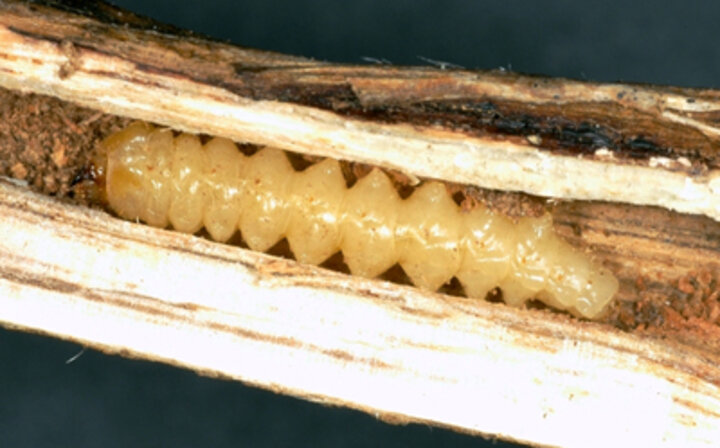August 15, 2008

|
| Soybean stem borer larvae. (Photos link to larger versions.) (Photos by Jim Kalisch) |

|
| Soybean stem borer adult. |
Crop consultants are reporting soybean stem borer in soybean fields in south central Nebraska. This beetle (Dectes texanus texanus) has been moving into Nebraska from north central Kansas over the last several years. Last fall Brandy Vanderwalle, UNL Extension Educator in Geneva, reported finding soybeans damaged by soybean stem borer in Fillmore County and surrounding areas.
Description
The adult is a gray, elongate beetle about 0.5 inch long with antennae that are longer than the body. Females lay eggs from late June through summer on various plants, including cocklebur, giant ragweed, sunflower, and soybean. On soybean, eggs are primarily laid in ovipositional punctures in the petioles. Larvae feed on the pith and tunnel down into the main stem. Each of four larval stages tunnels up and down the stem.
In the fall, mature larvae move to the base of the plant and girdle the inside of the stem about 2-4.5 inches above the soil line. The larvae pack frass in the tunnel at the girdle and the larvae overwinter in the stem below the girdle. Larvae then pupate for about two weeks within the stem in May to July, and adults emerge from late June through September.
Damage
Economic damage is caused primarily by lodging and subsequent harvest difficulties. Girdling is most severe in earlier maturing varieties, and lodging is most severe in earlier planted soybean. Chemical treatment of larvae is ineffective because the larvae are in the stem; effective chemical control of the adults is difficult due to the extended adult emergence period. Research found that burying borer-infested stubble after harvest can reduce Dectes populations.
Control
Entomologists at Kansas State University have been studying this insect as a pest on soybeans for several years. They have not identified resistance in any commercially available soybean cultivars, and labeled planting time and foliar insecticide applications were not effective in managing this insect. KSU has conducted a great deal of research on this insect. Their reports and extension publications can be found online at Soybean Stem Borer.
Fields with a history of injury or with symptoms this year should be carefully watched during August and September. Fields with extensive stalk tunneling by Dectes stem borer are at risk for lodging and harvest losses, depending on weather conditions. Those fields should be targeted for harvest first to minimize harvest losses due to stem borer injury.
Bob Wright
Extension Entomologist, Lincoln
Tom Hunt
Extension Entomologist
Haskell Ag Lab, Concord
